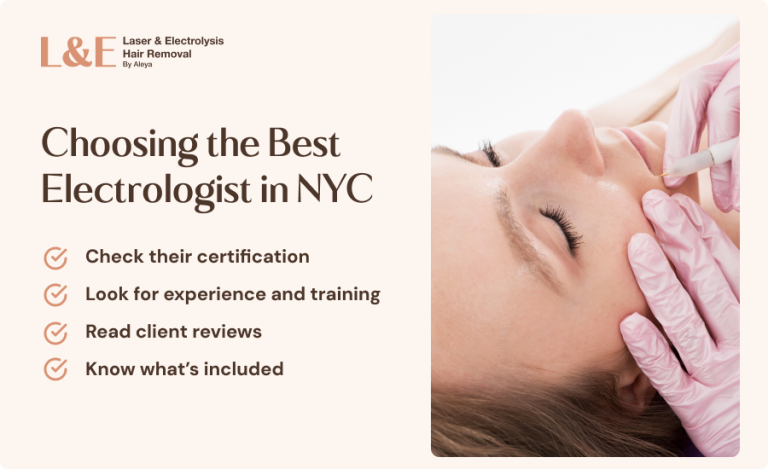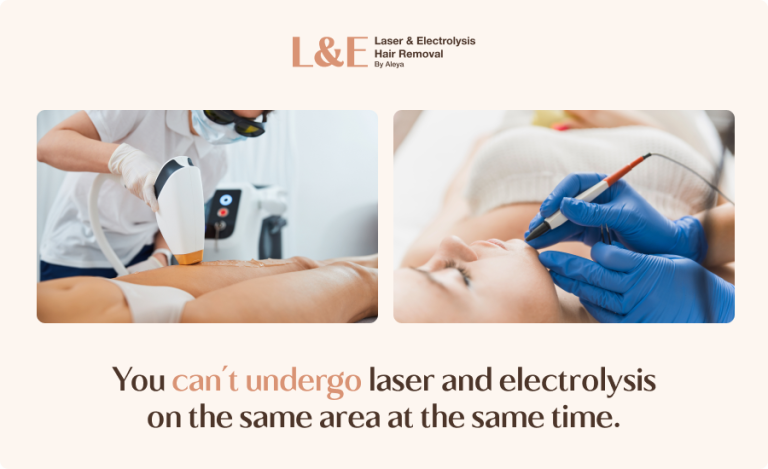The Complete Glossary Of Laser Hair Removal Terms

A
Acne:
Acne is a common skin condition that results in small red bumps or “pimples” to appear on the skin. Usually a result of hormone changes or bacteria, acne can be difficult to perform laser hair removal over.
Aleya Bamdad:
Top Laser and Electrolysis technician in Long Island. New York State Licensed Professional.
Axilla:
The medical term for the underarm. The hair that is in the armpit is technically known as Axilla Hair.
B
Bikini Hair Removal:
Bikini hair removal refers to the hair in pubic region of females, around where the edges of a bikini meet the skin. See here for the different styles of bikini laser hair removal.
Brazilian Hair Removal:
Brazilian is a style of bikini hair removal, where all hair above and between the legs is removed. See here for more information on Brazilian Laser Hair Removal.
Back:
The Back is a common area for men to experience burdensome hair. Laser is typically the preferred method of back hair removal.
Blend:
Blend is one of the three different kinds of electrolysis. It is a blend between the Galvanic and Thermolysis methods. For more information on the three types of electrolysis, see here.
C
Chest:
The chest is a common region of hair growth that many men prefer to reduce. The recommended method for chest hair removal is laser.
ChillTip:
The ChillTip is a patented feature of the LightSheer Diode Laser. It provides a constant cooling at the contact with the skin to maximize patient comfort and safety.
D
Diode Laser:
The Diode Laser is the type of laser used at Laser by Aleya in Long Island. The Diode is considered the gold standard of laser machines. It emits a longer wavelength than older models of lasers, resulting in safer and more protected results.
Depilatory Cream:
Depilatory creams are common hair removal creams such as Nair or Veet. They consist of a chemical substance that dissolves the hair at the surface level.
Dermis:
The dermis is the deep layer of skin underneath the surface. This is where the root of the hair follicle lives.
E
Electrolysis:
Electrolysis is a method of hair removal that works by sending small bursts of electricity into the hair follicle to destroy the hair. This method removes one hair at a time and is permanent.
EMLA Cream:
EMLA Cream is a commonly prescribed local anesthetic consisting of lidocaine and prilocaine. It is a topical ointment that causes a numbing sensation and is frequently used to reduce discomfort during laser hair removal or electrolysis sessions.
Epidermis:
The Epidermis is the surface layer of the skin. Hair reduction methods such as shaving only remove the hair at this level.
Exfoliation:
Exfoliation is the act of scrubbing the skin with an exfoliating solution (typically salt-based) to remove dead skin cells and soften the skin.
Eyebrows:
Because of their proximity to the eyes, eyebrows are a sensitive area for hair removal. For safety reasons, laser hair removal should not be performed on eyebrows.
F
Face:
Facial hair removal is common amongst men and women. Both Laser and Electrolysis can be performed on the face, however lasers can not be done on the eyebrows or near the eyes for safety reasons.
Follicle:
The follicle is the dynamic, cavity-shaped organ in which the hair grows. It resides in the dermal layer of the skin, with the hair surfacing at the epidermis. Laser hair removal and electrolysis are aimed at inactivating the hair at the root of the follicle.
G
Galvanic:
Galvanic is one of the three types of Electrolysis. It is the oldest and most reliable method, and is the one used at Laser by Aleya in Long Island. It works by sending an electrical current into the hair follicle to destroy the hair.
H
Hair:
A hair is a small growth on the body of mammals . They are typically considered to serve protective functions, such as keeping dirt and other particles from entering the eyes or ears.
Happy Trail:
The happy trail is the line of hair that grows from the belly button down to the pubic region. Laser is the preferred method for happy trail hair removal.
Hormones: Hormones play a central role in hair growth. A change in hormones, whether due to medication, hormone therapy, or birth control, can have an effect on the results of laser hair removal and electrolysis.
I
Ingrown Hair:
An ingrown hair is a common experience when a hair retreats inwards towards the follicle and begins to grow underneath the skin. It often results in a irritating bump. Ingrown hairs are a common reaction to waxing and shaving, but they are easily treatable.
J
K
L
Laser Hair Removal:
Laser hair removal is a form of prolonged hair removal that works by using wavelengths of light to penetrate the follicle and deactivate the hair.
Legs:
Legs are a common area for hair removal, especially amongst women. The preferred method for leg hair removal is laser.
LightSheer:
LightSheer is the brand that produces the Diode Laser used at Laser by Aleya. It is the leading producer of Lasers for hair removal purposes.
M
Mole:
Moles are a common spot for hairs to grow, and can be unsightly because they are often dark and wiry. Electrolysis should not be performed on moles to avoid triggering any cancerous side effects.
MTF:
Male-to-female transitioning individuals often find it preferable to use laser hair removal or electrolysis to reduce their body hair and achieve a more feminine look. For more information, see our blog post on MTF transgender laser hair removal.
N
O
P
Peach Fuzz:
Peach fuzz is the colloquial term for the thin hair that covers the the surface of a face, similar to the skin of a peach.
Probe:
The probe is the tool used in Electrolysis. The probe is inserted into the hair follicle, where it sends a burst of electricity that destroys the hair follicle.
R
Razor Bump:
Razor bumps are the small, red bumps that occur at the surface of the hair follicle after shaving. Not to be confused with razor burn, these small bumps are often a result of bacteria entering the pore.
Razor Burn:
Razor burn is a skin irritation that results from shaving. Razor burn is red and blotchy in appearance and often itches and stings like a rash.
Ruby:
The Ruby Laser is another popular type of laser used for hair removal. However, the Ruby Laser is considered outdated compared to the Diode
S
Shaving:
Shaving is a non-permanent form of hair removal that works by using a razor to cut hairs at a blunt edge at the surface of the skin. It often results in irritated skin, and the appearance of hair as thicker and darker when it grows back.
Skin Care:
Proper skin care is a central part of any safe and successful hair removal treatment. A skin care regimen, which includes regular use of sunscreen, should be maintained before and after laser hair removal treatments.
Sugaring:
Sugaring is a form of hair removal similar to waxing. A natural sugar substance is applied to the area of skin being treated and pulled off in a swift motion. While this form of hair removal is more gentle on the skin than waxing, it is not a permanent solution.
T
Threading:
Threading is an age-old practice of hair removal originating in India. The method involves plucking unwanted hairs out by using a twisted cotton thread. It is a popular technique for facial hair including eyebrows and upper lip.
Thermolysis:
Thermolysis is the third type of Electrolysis. It works by sending a radio frequency through the probe and into the hair follicle.
U
Upper Lip:
The upper lip region is a common area for women to grow hair. While often not as thick as that of a man, it is still undesirable for maintaining a feminine look. Many women choose to get either laser hair removal or electrolysis for upper lip hair removal.
V
W
Waxing:
Waxing is a very common method of hair removal. It works by applying warm wax to the skin, which clings to the hairs and rips them out when the wax is pulled off. While effective at removing large portions of hair at once, it is painful, impermanent, and can result in ingrown hairs.


![Top Bikini Laser Hair Removal Styles [Illustrations & FAQs]](https://www.laserbyaleya.com/wp-content/uploads/2025/06/bikini-laser-hair-removal-hero-image-updated-768x469.png)